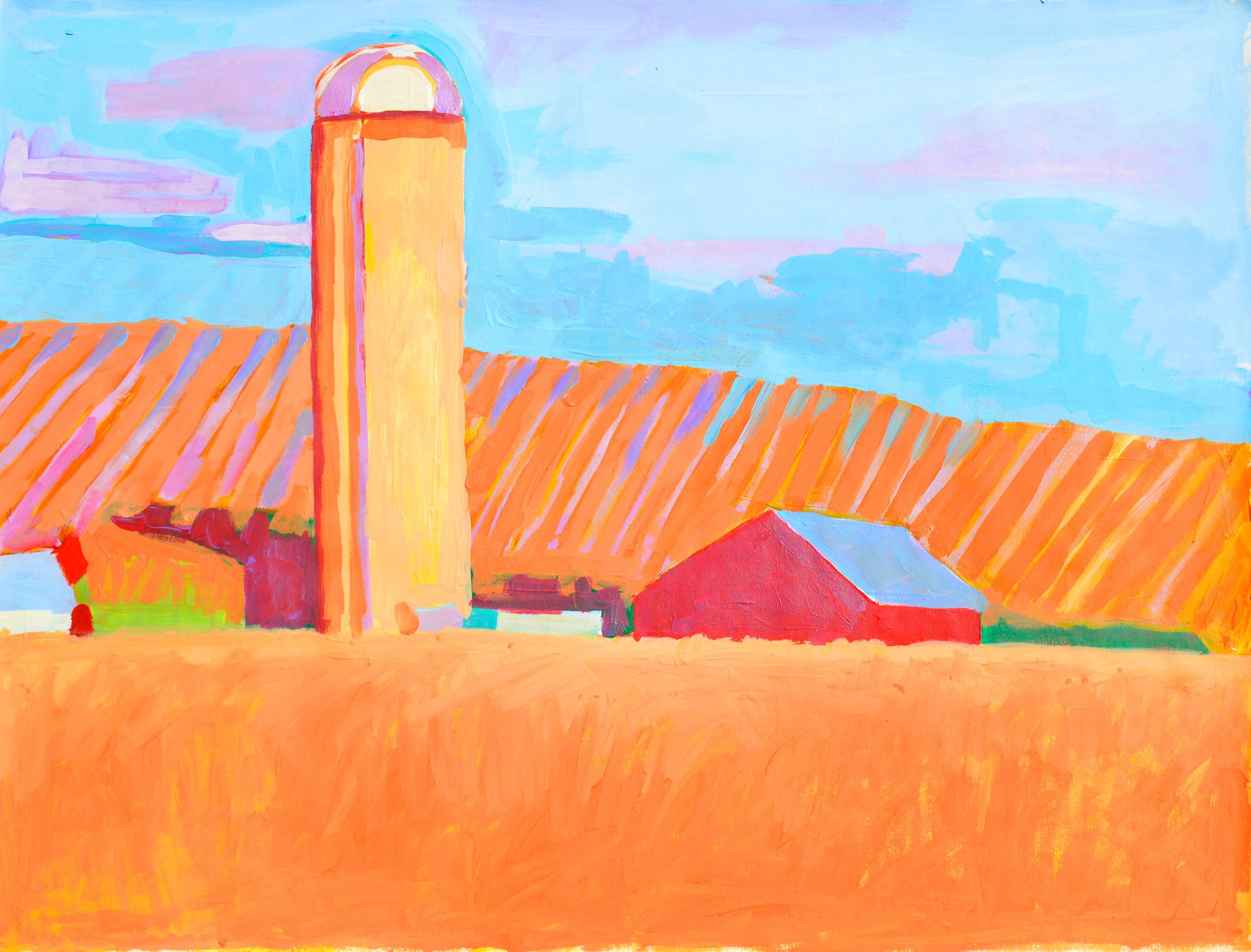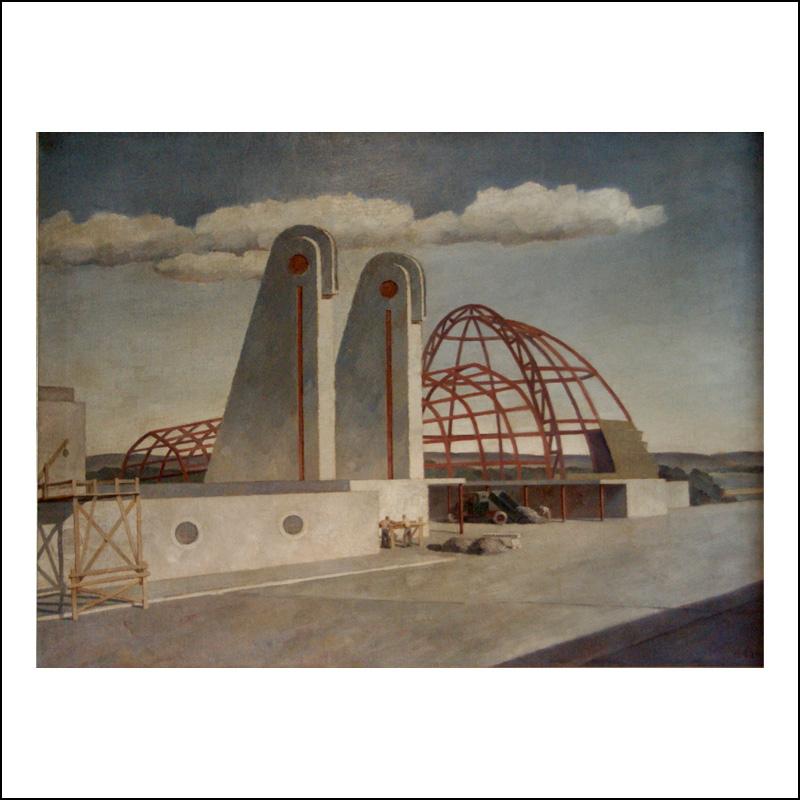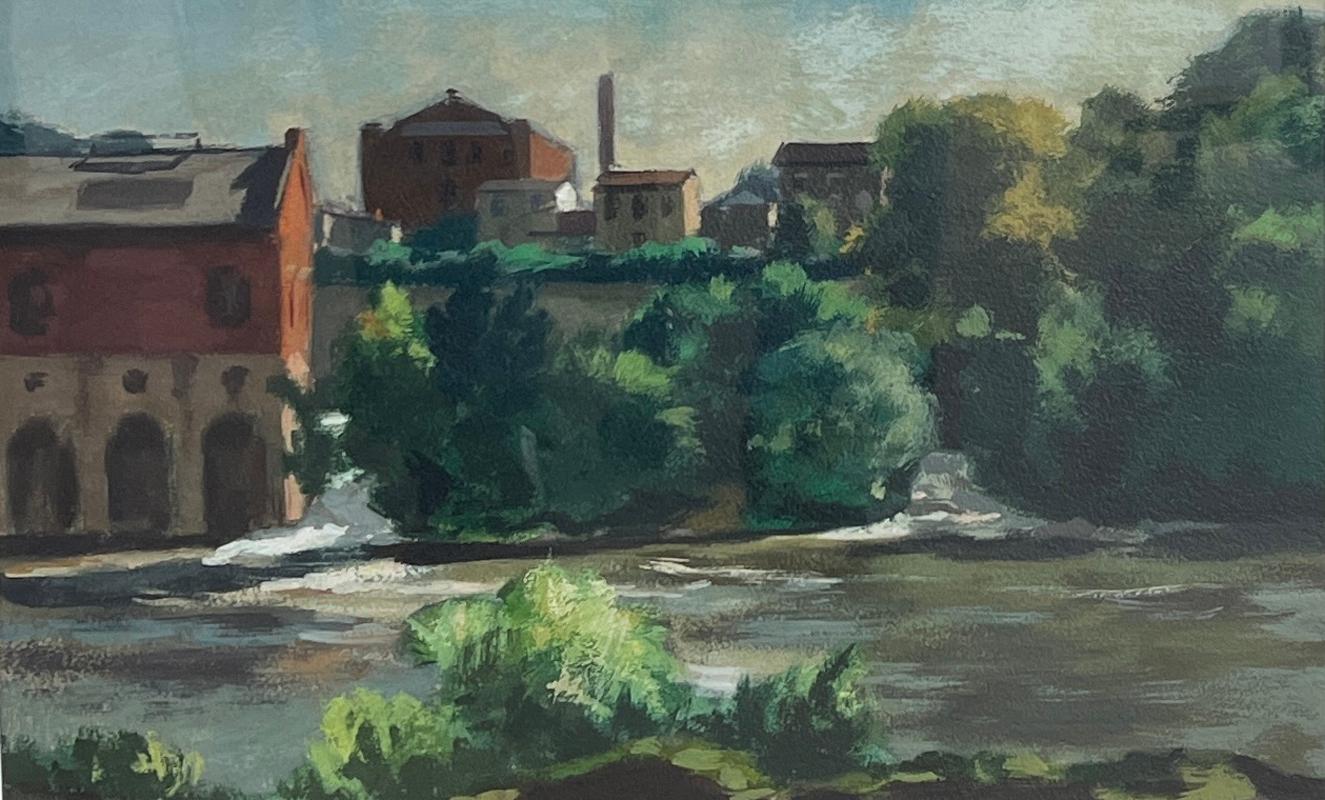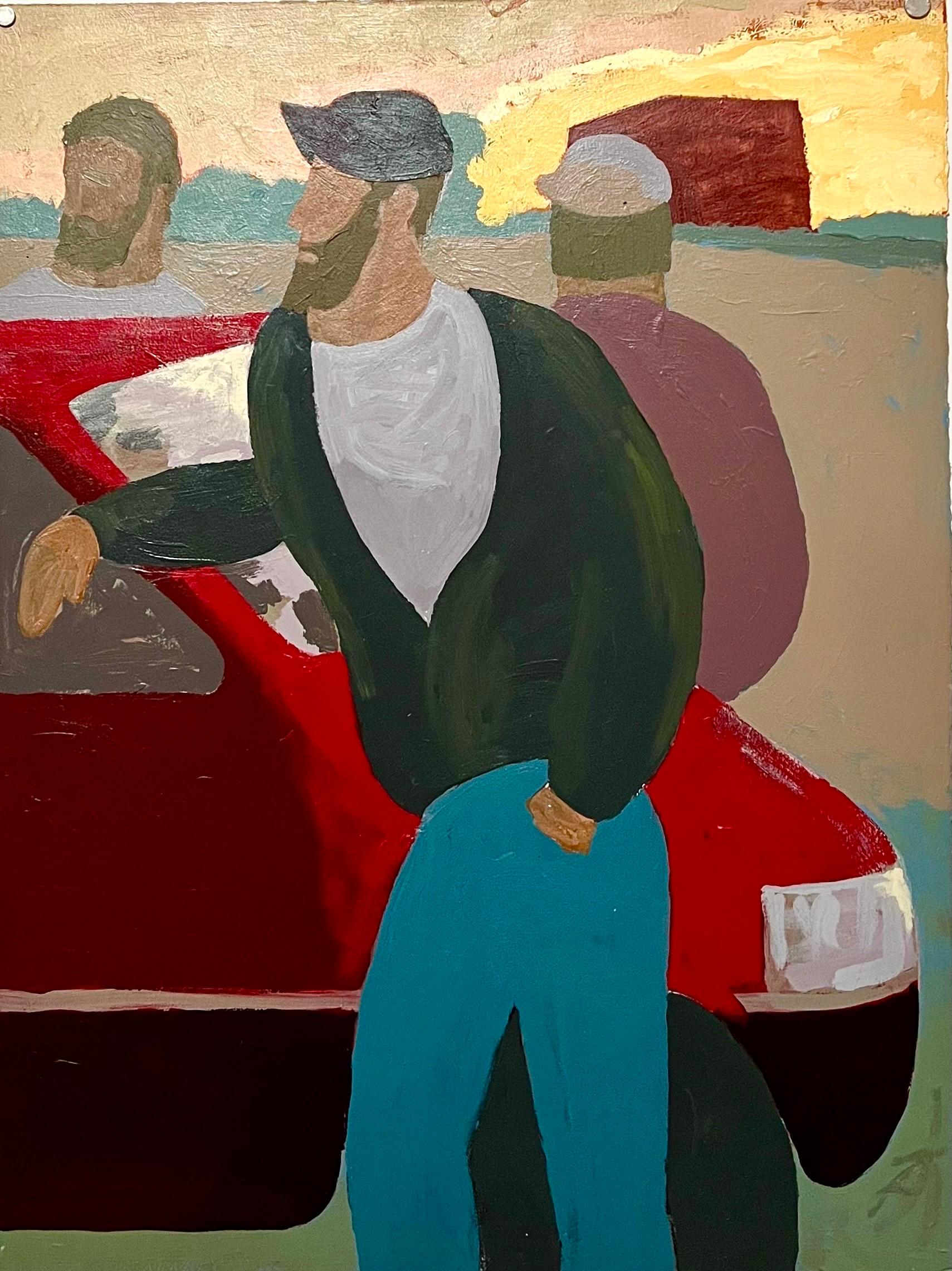Items Similar to Botanic Garden II, Modernist Oil Painting Pool With Flowers and Garden
Want more images or videos?
Request additional images or videos from the seller
1 of 7
Debra YooBotanic Garden II, Modernist Oil Painting Pool With Flowers and Garden1987
1987
About the Item
18.50" x 23.50" sight size
Debra Yoo received a degree in Fine Art and the Humanities from the University of Chicago, strongest influences were painting professor Vera Klement and the proximity of the Art Institute of Chicago. Her undergraduate work was primarily abstract, deeply influenced by Matisse, Russian icon painting, Robert Motherwell, and Barnett Newman.
After graduation she decided to pursue a growing interest in painterly realism. At that time Minimalism and Conceptualism were dominant, but there was (as there is still) a core of distinguished American artists who practiced the kind of contemporary realism based on modernism. Matisse continued to be a guiding light, but she also became interested in the work of Larry Rivers, Louisa Matthiasdottir, Edward Hopper, Richard Diebenkorn, John Singer Sargent, and contemporary still life painters in general. After seven years of work, she was offered representation by Jan Cicero Gallery in Chicago. Still life comprised the majority of her paintings for many years, with occasional dips into figure and landscape. Her works have been displayed at the Jan Cicero Gallery in Chicago, Andrea Marquit Fine Arts in Boston, and Greenhut Galleries in Portland, ME.
- Creator:Debra Yoo (American)
- Creation Year:1987
- Dimensions:Height: 27 in (68.58 cm)Width: 33 in (83.82 cm)
- Medium:
- Movement & Style:
- Period:
- Condition:no glass.
- Gallery Location:Surfside, FL
- Reference Number:1stDibs: LU38212562242
About the Seller
4.9
Platinum Seller
These expertly vetted sellers are 1stDibs' most experienced sellers and are rated highest by our customers.
Established in 1995
1stDibs seller since 2014
1,560 sales on 1stDibs
Typical response time: 1 hour
- ShippingRetrieving quote...Ships From: Surfside, FL
- Return PolicyA return for this item may be initiated within 3 days of delivery.
More From This SellerView All
- Large Hudson River Figurative Modernist Landscape Oil Painting Edward AvedisianBy Edward AvedisianLocated in Surfside, FLEdward Avedisian ( 1936-2007 ) Gouache or oil on paper, 3 guys around a car, hand signed in paint lower left, Measures 30"x 22.5" Edward Avedisian (June 15, 1936, Lowell, Massachusetts – August 17, 2007, Philmont, New York) was an American abstract painter who came into prominence during the 1960s. His work was initially associated with Color field painting and in the late 1960s with Lyrical Abstraction and Abstract Expressionism. He studied art at the School of the Museum of Fine Arts, Boston. By the late 1950s he moved to New York City. Between 1958 and 1963 Avedisian had six solo shows in New York. In 1958 he initially showed at the Hansa Gallery, then he had three shows at the Tibor de Nagy Gallery and in 1962 and 1963 at the Robert Elkon Gallery. He continued to show at the Robert Elkon Gallery almost every year until 1975. During the 1960s his work was broadly visible in the contemporary art world. He joined the dynamic art scene in Greenwich Village, frequenting the Cedar Tavern on Tenth Street, associating with the critic Clement Greenberg, and joining a new generation of abstract artists, such as Darby Bannard, Kenneth Noland, Jules Olitski, and Larry Poons. Avedisian was among the leading figures to emerge in the New York art world during the 1960s. An artist who mixed the hot colors of Pop Art with the cool, more analytical qualities of Color Field painting, he was instrumental in the exploration of new abstract methods to examine the primacy of optical experience. One of his paintings was appeared on the cover of Artforum, in 1969, his work was included in the 1965 Op Art The Responsive Eye exhibition at the Museum of Modern Art and in four annuals at the Whitney Museum of American Art. His paintings were widely sought after by collectors and acquired by major museums in New York and elsewhere. He has been exhibited in prominent galleries, such as the Anita Shapolsky Gallery and the Berry Campbell Gallery in New York City. Edward Avedisian was known for his brightly colored, boldly composed canvases that combined Minimalism's rigor, Pop art exuberance and the saturated tones of Color Field painting. Roberta Smith of the NYT writes of Avedesian: "Edward Avedisian helped establish the hotly colored, but emotionally cool, abstract painting that succeeded Abstract Expressionism in the early 1960s. This young luminary harnessed elements of minimalism, pop, and color field painting to create prominent works of epic proportions that energized the New York art scene of the time." In 1996 Avedisian showed his paintings from the 1960s at the Mitchell Algus Gallery, then in SoHo. His last show, dominated by recent landscapes, was in 2003 at the Algus gallery, now in Chelsea. Selected Exhibitions: Op Art: The Responsive Eye, at the Museum of Modern Art, Whitney Museum’s Young America 1965 Expo 67, held in Montreal, Canada. Six Painters (along with Darby Bannard, Dan Christensen, Ron Davis...Category
20th Century American Modern Landscape Paintings
MaterialsOil, Gouache, Archival Paper
- Bathers at the Quarry 1940s American Modernist Oil Painting WPA eraBy Theresa Berney LoewLocated in Surfside, FLSwimmers and sun tanners at the local watering hole. Her birth name was Theresa Berney. At the time of her passing she was known as Theresa Loew. Birth place: Baltimore artist, blo...Category
1940s American Modern Landscape Paintings
MaterialsOil, Board
- 1930 Oil Painting Sea Side Sailboats American Modernist WPA Artist Morris KantorBy Morris KantorLocated in Surfside, FLMorris Kantor, American, 1896-1974 Seaside View, 1930 Hand signed M. Kantor and dated 1930 lower right Oil on canvas 22 1/4 x 19 1/4 inches 24 1/2 x 21 (frame) Morris Kantor (Belarusian: Морыс Кантор) (1896-1974) was a Russian Empire-born American painter based in the New York City area. This is a beautiful boat scene with a river or lake probably on Long Island. Born in Minsk on April 15, 1896, Kantor was brought to the United States in 1906 at age 10, in order to join his father who had previously relocated to the states. He made his home in West Nyack, New York for much of his life, and died there in 1974. He produced a prolific and diverse body of work, much of it in the form of paintings, which is distinguished by its stylistic variety over his long career. Perhaps his most widely recognized work is the iconic painting "Baseball At Night", which depicts an early night baseball game played under artificial electric light. Although he is best known for his paintings executed in a realistic manner, over the course of his life he also spent time working in styles such as Cubism and Futurism, (influenced by the Art Deco movement) and produced a number of abstract or non-figural works. A famous cubist, Futurist, painting of his "Orchestra" brought over 500,000$ at Christie's auction house in 2018. Kantor found employment in the Garment District upon his arrival in New York City, and was not able to begin formal art studies until 1916, when he began courses at the now-defunct Independent School of Art. He studied landscape painting with Homer Boss (1882-1956). In 1928, after returning to New York City from a year in Paris, Kantor developed a style in which he combined Realism with Fantasy, often taking the streets of New York as his subject matter. He did some moody Surrealist Nude paintings and fantasy scenes. In the 1940's he turned towards figural studies. Later in his career, Kantor himself was an instructor at the Cooper Union and also at the Art Students League of New York in the 1940s, and taught many pupils who later became famous artists in their own right, such as Knox Martin, Robert Rauschenberg, Sigmund Abeles and Susan Weil...Category
1930s American Modern Landscape Paintings
MaterialsCanvas, Oil
- Large Modernist Oil Painting 1940s, Judaica Hasidic Shtetl Wagon Driver WPA EraBy Emanuel Glicenstein RomanoLocated in Surfside, FLGenre: Modern Subject: Landscape with figure of horse, driver and wagon Medium: Oil Surface: wood Board EMANUEL ROMANO Rome, Italy, b. 1897, d. 1984 Emanuel Glicen Romano was born in Rome, September 23, 1897. His father Henryk Glicenstein was a sculptor and was living in Rome with his wife Helena (born Hirszenberg) when Emanuel was born. His father obtained Italian citizenship and adopted the name Enrico. Emanuel was brought up in Italy, Switzerland, Germany, England and Poland. In 1926 Emanuel Glicenstein Romano and his father sailed for New York. They briefly visited Chicago. Romano's sister, Beatrice, and mother only joined them in New York years later. Romano changed his name on his arrival to America and some have erroneously speculated that this was to avoid antisemitic discrimination. In truth, as the son of a highly-regarded artist, Romano changed his name to ensure that any success or recognition he would later attain, would be the result of nothing other than his own merit as an artist, and not on account of his father's fame. In 1936 Romano was worked for the WPA Federal Art Project creating murals. ( there were many jewish artists active with in the WPA period. notably Chaim Gross, Ben Shahn, Isaac and Moses Soyer, Abraham Rattner and many others. During and immediately after World War II, Romano created a series of allegorical works depicting graphic holocaust images that were held closely by the family until after his passing. One of these works is now on permanent display in the Florida Holocaust Museum in St. Petersburg Florida. Emanuel's father died in 1942 in a car accident before they could realize their shared dream of visiting Israel. In 1944 Romano, having completed his degree at the Pennsylvania Academy of Fine Arts and the Art Institute of Chicago, began teaching at the City College of New York. Romano moved to Safed, Israel in 1953 and established an art museum in his father's memory, the Glicenstein Museum. COLLECTIONS Indianapolis Museum of Art Metropolitan Museum of Art Boston Fine Arts Museum Fogg Museum Musée Nacional de France Recently his work has been added to the Florida Holocaust Museum collection. His notable works include his holocaust themed allegorical paintings as well as portraits of Marianne Moore, his father and William Carlos Williams...Category
1930s American Modern Figurative Paintings
MaterialsOil, Board
- Wild Flowers Vibrant Colorful Modernist Oil PaintingBy John WengerLocated in Surfside, FLJohn Wenger (1887-1976) celebrated easel painter and stage set designer whose career included 25 solo shows in the USA, Canada, and Europe. He created set designs for such plays as "Ile", "Petrushka", "Funny Face", and Rhapsody In Blue". John Wenger's art is included in many museums in and out of the USA. John Wenger was born on June 16, 1887 in Elizabethgrad, Russia. Wenger was born an artist, and at the age of three was painting (playing) with brushes and paint while his father, a local artist who painted scenery for the traveling theater, worked on drop scenes. His mother disapproved of this and tried to keep her son from playing with these "toys." When John Wenger was several years older, he attended Gihnazia, which is equivalent to high school but on a college level. Throughout his education Wenger excelled in visual arts. The staff at the Gihnazia school encouraged him to apply to the Imperial Art Academy of Odessa for a scholarship. At the age of thirteen, John Wenger became a student at the academy. For Wenger, this was his first time away from home and he found it to be difficult for several months. When he came to America in 1903, John earned his living by designing ladies costumes and jewelry at his uncles store in Newark, New Jersey. He then resumed his art studies at Cooper Union and The National Academy of Design. While in New York, Wenger found an interest in how music and theater connected to art. He rebelled against the heavy sets and hard lines of stage scenery...Category
Mid-20th Century American Modern Still-life Paintings
MaterialsOil
- Modernist Impasto Painting Mountain with Ocean Landscape J. James AkstonLocated in Surfside, FLJ. James Akston Mountain Landscape by ocean Acrylic on Board Frame: 11.5 x 16. Image: 5 X 9.5 Joseph James Akston was a Polish American sculptor, painter, known for surrealist abstract painting and Aubusson (for Les Ateliers Pinton Frères, tapisserie, Aubusson) tapestry artist. Born in Warsaw, Poland in 1898 he died in Palm Beach Florida in 1983. During the 1960s and '70s the entrepreneur-artist James Joseph Akston adopted a unique Surreal Expressionist style in order to present his private primordial universe and lampoon its denizens, a ribald cast of animal creatures with human foibles. A successful industrialist, he began his career with General Motors foreign operations and then started his own business. Intermittently he studied painting, first with Jerry Farnsworth in North Truro (Mass.) and then with Jose Clemente Orozco in Mexico. In the early 1960s Akston became publisher-editor of a group of art publications which included The Magazine Arts. Initially an abstract expressionist, Akston had one-man exhibitions at the New York Convention Center and the Corcoran Museum in Washington. Since 2015 the record price for this artist at auction is $12,575 USD for Spheres Aux Triangles Aubusson Tapestry, sold at Bonhams New York in 2019. He was a Graduate of Georgetown University. He sat on the board of the Norton Museum. Exhibitions 1976 Hokin Gallery 1966 Gallery 63 NYC 1960 Gallery 63 Rome , Italy Select Public Collections National Museum, Wshington DC Boca Museum of Art Whitney Museum of Art, NYC Museum of Modern Art, NYC Museum of African Art Washington DC (Now part of Smithsonian Museum) Bibliography: 1962 Art...Category
Mid-20th Century American Modern Landscape Paintings
MaterialsOil
You May Also Like
- Farmland in Autumn, Modern Pastoral LandscapeBy Michael William EgglestonLocated in Soquel, CAVivid landscape of farmland in highly saturated autumnal hues by San Francisco artist Michael William Eggleston (American, 20th century). Unsigned and unframed, from a collection of ...Category
Early 2000s American Modern Landscape Paintings
MaterialsOil, Paper
- 1, 000 piece Museum Quality Collection of Art & Objects from NYC 1939 Worlds FairBy Harry LaneLocated in New York, NY1,000 piece Museum Quality Collection of Art & Objects from NYC 1939 Worlds Fair Harry Lane (1891-1973) "1939 World’s Fair Construction," 30 x 40 inches, Oil on canvas, signed lower...Category
1930s American Modern Landscape Paintings
MaterialsCanvas, Photographic Paper, Plaster, Oil
- Manayunk, Schuylkill River, Factory, City Scene Philadelphia, Pennsylvania 1970By Giovanni MartinoLocated in Rancho Santa Fe, CAProvenance: Private Collection, San Diego, CA. Framed Giovanni Martino, National Academy of Design* member, was born on May 1, 1908 in Philadelphia PA where all seven brothers and one sister, Filomina, Frank, Antonio, Albert, Ernest, Giovanni, Edmond, and William became painters. They were under the tutelage of their eldest brother, Frank, who in the late 1920s, founded the first commercial art* studio, Martino Studios, at 27 South 18th Street. Besides studying with his two eldest brothers, Giovanni also studied with Albert Jean Adolph at La France Institute, The Pennsylvania Academy of the Fine Arts*, The Graphic Sketch Club, and Spring Garden Institute in Philadelphia. In his mid teens he accompanied his two eldest brothers to New Hope searching for subjects to paint. In the 1930s, he also started to paint in Manayunk, a hilly mill town along the Schuylkill River. At this time he signed his paintings M. Giovanni. These colorful impressionistic* works proceeded more thinly painted dramatically poetic street scenes of the mill town. These images developed into impasto* laden oils in the 1960's with some of the paintings worked with a palette knife*. In Manayunk, he was a common sight on the streets and sidewalks, painting on-the-spot with his wife, Eva Marinelli and his two daughters, Nina & Babette. In the 1980's and 90's he also painted in Conshohocken and Norristown with his youngest daughter, Babette. His paintings became more sharply executed like his earlier work but were more colorful. In the late '90's he worked in his studio to enlarge paintings. He is the recipient of over 100 awards and honors. He received the Benjamin Altman Prize in Landscape Painting in 1975 at the National Academy of Design, NYC where he was elected an Academician (NA) in 1944. He mentored not only his wife and two daughters but also taught at Lehigh University and the Graphic Sketch Club, Philadelphia. He died at his home in Blue Bell on February 1, 1997. (Babette Martino...Category
1970s American Modern Landscape Paintings
MaterialsMixed Media, Paper, Oil, Tempera
- Fitzhugh Mine, near Leadville, Colorado, Mountain Mining Landscape Oil PaintingLocated in Denver, COOil on mounted paper, Colorado modern mountain landscape painting by early 20th Century female artist, Eldora Pauline Lorenzini (1910- 1993) from 1937....Category
1930s American Modern Landscape Paintings
MaterialsOil, Archival Paper
- Large 1960 California "Abstract Landscape" Jack Stuck PaintingLocated in Arp, TXJack Stuck (1925-1993) "Abstract Landscape" 1960 Collage oil paint, charcoal, paper and canvas laid down on masonite 48"x46" natural wood frame 51" x 49" Si...Category
Mid-20th Century American Modern Abstract Paintings
MaterialsCanvas, Masonite, Charcoal, Oil, Laid Paper
- Vintage Modernist Landscape Painting, Monument Valley Arizona, listed artistLocated in Baltimore, MDAlthough born in Ohio at the end of the 19th century, Martin Sabransky studied art at Randolph Macon College in Virginia. He began his career path moving west, by first going to Kans...Category
Mid-20th Century American Modern Landscape Paintings
MaterialsOil
Recently Viewed
View AllMore Ways To Browse
Vintage Oil Paintings Of Flowers
Botanical Modern Art
Contemporary Botanical Painting
Realism Flower Painting
Botanical Oil
Realism Paintings Of Flowers
Botanical Oil Painting
Boston Garden
Vintage Botanical Art
Flower Guide
Russian Realism
Larry Rivers
Pool Oil Painting
Flower Painting Russia
Russian Flower Painting
Landscape Pool Painting
Flower Icon Painting
John Richard Oil Painting




